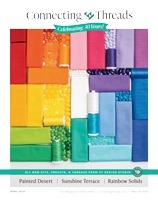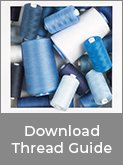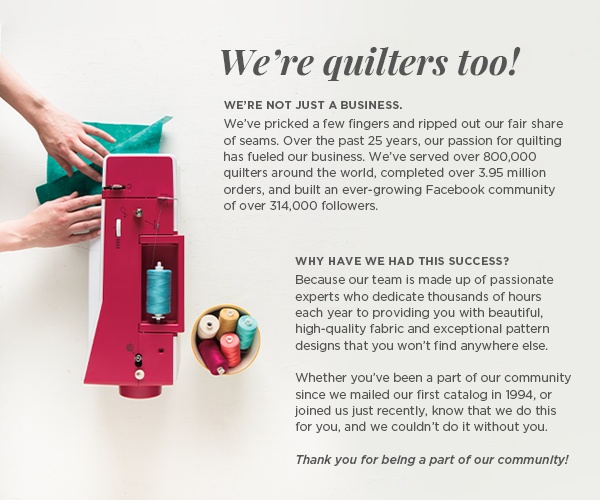A Guide to Beginner Tools
When quilters are first starting out, it’s tremendously hard to know which tools you will need for quilting. You walk down the craft store aisles and it is easy to get overwhelmed by everything to look through and choose from. We want to make sure that the tool selection process is as simple and straight forward as possible for you. We’ve broken out all of the “essential” tools you’ll need, and explained each tool’s purpose and function. With these great items in tow, you’ll be quilting away in no time.

Rotary Cutter
Rotary cutters are used to get super straight, clean cuts from your fabric. For beginners, we recommend starting with a 45mm blade. Rotary cutters come in a variety of sizes – from 18mm to 60mm. The 18mm and 28mm cutters are used primarily for curved piecing, and the 60mm is designed to cut through multiple layers of fabric, batting, and difficult materials. Like the 60mm blade, the 45mm can cut through 2-3 layers of fabric at a time and is typically much more user-friendly for beginners. Similar to the story of Goldilocks and the three bears, the 45mm cutter is just right.

Self-Healing Mat
Self-healing mats are what you will use to cut fabric on when using your rotary cutter. Most cutting mats are reversible and come with ruler grids to assist you with measuring and aligning your fabrics. While cutting mats come in many sizes, a 24” x 36” mat is good size to start with. Because a Fat Quarter and a folded half yard both measure 18” x 22”, a smaller mat may not allow for enough visibility when cutting.

Pins
Pins are essential for securing fabric layers so that you can sew precisely. When you use pins, you are more likely to get your seams right the first time, thereby resulting in less ripping out. The best choice for a beginner quilter would be a fine, sharp, glass-headed pin. The added bonus of the glass head means that the pin top won’t melt under your iron.

Rulers
Every new quilter needs at least one ruler. We suggest starting with a ruler that is 6”x24”. The longer rulers allow you to easily make cuts along the entire width of the fabric. Because you may occasionally need to cut strips wider than your ruler, we also suggest purchasing a smaller ruler (6”x12”) to make that process a little easier. Finally, you may also choose to purchase a 12-1/2” square ruler to use when squaring up. The smaller rulers also make it easier to cut smaller pieces. It’s a good idea to find a ruler that has measurement increments down to an eighth of an inch. Whatever you do, don’t skimp on your ruler. This is a tool that you will use for years and years to come, and the accuracy and quality of the ruler is key to your quilting success.

Scissors
While most projects are cut using a rotary cutter, sewing scissors are great to have around for special projects like templates. In total, your sewing room should ultimately have three different pairs of scissors: a small pair to cut loose threads, a pair to cut paper, and a pair strictly to be used for cutting fabrics.

Seam Ripper
Every quilter needs a seam ripper. Seam rippers are great to have around because after all, you can’t sew a perfect seam every time! Truth be told, there are several seam rippers stashed around the Connecting Threads offices.

Iron
You don’t need a fancy, expensive iron when you’re first getting started. The main suggestion that we would make is that you purchase an iron that has the option to produce steam. That feature comes in very handy when getting wrinkles out of the fabrics and setting your seams.

Sewing Machine
As with the iron, you don’t need anything fancy when you’re getting started. If your sewing machine can sew a straight line, you have everything you need to begin piecing. We suggest buying for your skill level and over time, add features as you become confident that you will use them.

Sewing Machine Needles
There are many different types of sewing machine needles, and a lot of variables to consider when choosing the right one. Your sewing machine, your thread type and size, and the fiber content and thickness of the fabric you are using all factor into deciding what needle you should use. You should also change your needle often. I’ve heard the rule that you should change your needle every time you start a new project. Titanium-coated needles have been available for industrial and long arm machines for years and are now available for home sewing machines. They have a very thin layer of titanium nitride that keeps them sharper longer. They last longer than other needles so you don’t have to change them as often. You can learn more about the different needles available and the types you should look for in our needles tutorial here: Machine Sewing Needles 101

Hand Sewing Needles
Choosing the right needle for the job can be overwhelming when there are so many kinds and sizes. Ideally, what you want is a needle that feels comfortable, glides through the fabric, has an eye that you can thread, doesn’t bend and is the right size for the fabric you are sewing. When you choose your hand sewing needle size, the larger the number on the package, the finer/smaller the needle will be. This is the opposite of the needles you purchase for your sewing machine. If you are using finer/thinner fabric you would select a finer/smaller needle. Needles are normally made of high carbon steel and then coated with nickel, gold, Teflon, or platinum. The coatings are put on to prevent the needle from corroding and to make the needle glide through the fabric. Learn more about the different types of Hand Sewing Needles in our tutorial here: Hand Sewing Needles 101

Marking Tools
Marking tools are a handy thing to have around for a multitude of purposes. Whether it be marking your fabrics, tracing patterns, making notes, etc., the most important thing is that the marks you make on your fabrics only last as long as you need them. Before you use your marking tool , read the instructions and understand how it gets erased. The type of marking tool that one uses is entirely up to the person. Some people prefer soapstone, others like pencils, and some like pens. Quilter’s pencils are available in white or gray lead and have eraser ends for easy removal. The leads are oil free and contain less graphite to prevent smearing. Soapstone pencils are made of pressed talc and can be sharpened to a fine point and rubbed off or wiped with a damp cloth. Water-soluble pens are another great option and the marks can typically be rubbed off easily.

Thread
Which thread do I use? This is a common question that springs to mind when shopping for thread and you are confronted with a mass of spools containing different fibers and weights in rainbows of colors. Cotton, polyester, rayon, silk, oh my! We have an entire thread tutorial dedicated to helping you find the perfect thread to meet your needs. Of course, we highly recommend our Essential Cotton thread for all of you beginners out there! Read our thread tutorial here:










